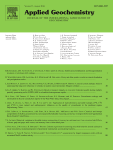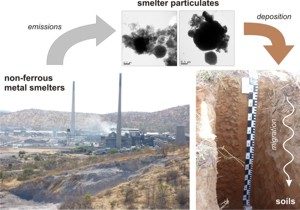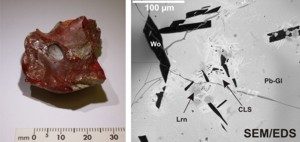 We have co-edited a special issue of Applied Geochemistry devoted to Environmental impacts of mining and smelting. Some of our research has also been published in the frame of this special issue: (i) Kříbek B., Majer V., Knésl I., Keder J., Mapani B., Kamona F., Mihaljevič M., Ettler V., Penížek V., Vaněk A., Sracek O. (2016): Contamination of soil and grass in the Tsumeb smelter area, Namibia: Modeling of contaminants dispersion and ground geochemical verification. Applied Geochemistry 64, 75-91. (DOI), (ii) Ettler V., Kvapil J., Šebek O., Johan Z., Mihaljevič M., Ratié G., Garnier J., Quantin C., (2016): Leaching behaviour of slag and fly ash from laterite nickel ore smelting (Niquelandia, Brazil). Applied Geochemistry 64, 118-127. (DOI), (iii) Ratié G., Quantin C., Jouvin D., Calmels D., Ettler V., Sivry Y, Vieira L.C., Ponzevera, E., Garnier J. (2016): Nickel isotope fractionation during laterite Ni ore smelting and refining: Implications for tracing the sources of Ni in smelter-affected soils. Applied Geochemistry 64, 136-145. (DOI).
We have co-edited a special issue of Applied Geochemistry devoted to Environmental impacts of mining and smelting. Some of our research has also been published in the frame of this special issue: (i) Kříbek B., Majer V., Knésl I., Keder J., Mapani B., Kamona F., Mihaljevič M., Ettler V., Penížek V., Vaněk A., Sracek O. (2016): Contamination of soil and grass in the Tsumeb smelter area, Namibia: Modeling of contaminants dispersion and ground geochemical verification. Applied Geochemistry 64, 75-91. (DOI), (ii) Ettler V., Kvapil J., Šebek O., Johan Z., Mihaljevič M., Ratié G., Garnier J., Quantin C., (2016): Leaching behaviour of slag and fly ash from laterite nickel ore smelting (Niquelandia, Brazil). Applied Geochemistry 64, 118-127. (DOI), (iii) Ratié G., Quantin C., Jouvin D., Calmels D., Ettler V., Sivry Y, Vieira L.C., Ponzevera, E., Garnier J. (2016): Nickel isotope fractionation during laterite Ni ore smelting and refining: Implications for tracing the sources of Ni in smelter-affected soils. Applied Geochemistry 64, 136-145. (DOI).
 A new open-access review paper, published within a special issue of Applied Geochemistry can also be downloaded from the website of our group: Ettler V. (2016): Soil contamination near non-ferrous metal smelters: A review. Applied Geochemistry 64, 56-74. (PDF)
A new open-access review paper, published within a special issue of Applied Geochemistry can also be downloaded from the website of our group: Ettler V. (2016): Soil contamination near non-ferrous metal smelters: A review. Applied Geochemistry 64, 56-74. (PDF)





 We have co-edited a special issue of Applied Geochemistry devoted to Environmental impacts of mining and smelting. Some of our research has also been published in the frame of this special issue: (i) Kříbek B., Majer V., Knésl I., Keder J., Mapani B., Kamona F., Mihaljevič M., Ettler V., Penížek V., Vaněk A., Sracek O. (2016): Contamination of soil and grass in the Tsumeb smelter area, Namibia: Modeling of contaminants dispersion and ground geochemical verification. Applied Geochemistry 64, 75-91. (
We have co-edited a special issue of Applied Geochemistry devoted to Environmental impacts of mining and smelting. Some of our research has also been published in the frame of this special issue: (i) Kříbek B., Majer V., Knésl I., Keder J., Mapani B., Kamona F., Mihaljevič M., Ettler V., Penížek V., Vaněk A., Sracek O. (2016): Contamination of soil and grass in the Tsumeb smelter area, Namibia: Modeling of contaminants dispersion and ground geochemical verification. Applied Geochemistry 64, 75-91. ( First detailed mineralogical investigation of early medieval slags indicated that in the second half of 12th century, large metallurgical complex, where silver production based on cupellation process, has been active. Our Pb isotope analyses of smelting remains suggest that Pb needed for the cupellation originated probably from mines in Poland. Ettler V., Johan Z., Zavřel J., Walisová M.S., Mihaljevic M., Šebek O. (2015): Slag remains from the Na Slupi site (Prague, Czech Republic): evidence for early medieval non-ferrous metal smelting. Journal of Archeological Science 53, 72-83. (
First detailed mineralogical investigation of early medieval slags indicated that in the second half of 12th century, large metallurgical complex, where silver production based on cupellation process, has been active. Our Pb isotope analyses of smelting remains suggest that Pb needed for the cupellation originated probably from mines in Poland. Ettler V., Johan Z., Zavřel J., Walisová M.S., Mihaljevic M., Šebek O. (2015): Slag remains from the Na Slupi site (Prague, Czech Republic): evidence for early medieval non-ferrous metal smelting. Journal of Archeological Science 53, 72-83. (